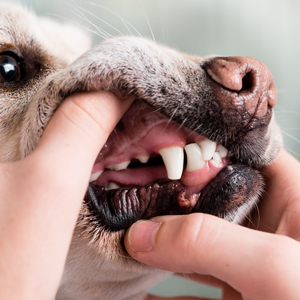
February is National Pet Dental Health Month, so we sat down with our own Dr. Mark Williamson for information that he thought our clients should be aware of.
So, here are 5 Interesting Facts About Dog Teeth that everyone should be aware of.
1. Dogs Go Through Two Sets of Teeth in Their Lifetime
Just like baby teeth, dogs have puppy teeth that will fall out and be replaced with adult teeth.
“Puppy teeth are commonly called ‘deciduous teeth’ or ‘milk teeth’, and work much like an adult dog’s teeth but on a smaller scale,” Dr. Williamson says. “Starting around 4 months of age and extending to around 6 months of age, the deciduous teeth begin to exfoliate. Compared to people, in which the process takes place over years, for puppies, the transition is very rapid – just a matter of weeks.”
Dr. Williamson states that, “Puppies lose their teeth in a way that is similar to children—they become loose and eventually fall out. The root of the tooth is then naturally absorbed into the gums.”
2. Adult Dogs Have More Teeth Than Humans
Dr. Williamson explains that, “Puppies have only about 28 deciduous dog teeth that they shed to make way for permanent adult dog teeth. Adult dogs have 42 teeth, while most people have 32. In comparison, adult cats have 30 teeth.”
Adult dog teeth begin to form before birth. “Later in life, they push-through, into position, as their deciduous counterparts are shed,” he says.
3. Dogs Use Their Teeth Differently Than People
While the makeup and chemical structure of dog teeth is similar to those of human teeth, the size and shape of dog teeth are where the biggest differences come into play.
“The most prominent teeth are the long and pointy canines,” Dr. Williamson told us. “They are used for grasping, lifting, pulling and, potentially, for defense. The large carnassial teeth are further back in the mouth, and are designed to shear against one another, to provide a slicing action.”
This is in contrast to human teeth, which typically grind against one another to pulverize food. Dogs can’t really smash up their food like people because their teeth are not designed that way.
4. Canine Teeth Root Structure Differs a Bit From People
“Canine root structures are similar to human root structures except that in dogs, the three upper molars have two roots, whereas the two lower molars have three roots,” says Dr. Williamson.
Additionally, the roots of a dog’s tooth are long. “Most people are surprised by how long the roots are,” Williamson notes. “The visible crown is usually only about one-third the length of the tooth. For incisor teeth, the crowns are only about one-fourth the length of the tooth.”
5. Cavities in Dog Teeth Are Extremely Rare
Because the bacteria in a dog’s mouth are different from the bacteria in a human’s mouth, cavities in dogs don’t happen often.
“Cavities are caused by specific bacteria that live on flat surfaces of teeth and metabolize sugars into acid,” says Dr. Williamson. “Dogs don’t normally consume as much sugar as people do, and the species of bacteria that causes cavities is very rare in dogs’ mouths.”
When cavities occur in dogs, they are usually caused by sweet treats, such as bananas or sweet potatoes. “The treatment for cavities in dogs is the same as for people,” he says. “The diseased tooth structure is removed and replaced with a composite filling.”
Signs of Dental Disease in Dogs
Pet parents should watch for signs of periodontal disease in dogs. If you notice any signs of dental or gum disease, you should consult your veterinarian for care tips.
Most dog owners don’t recognize that their dogs have a problem until the disease has progressed to an advanced stage. Further, dogs instinctively try to hide any pain or discomfort to avoid showing weakness, making it even harder to recognize a problem is present.
 Signs of Periodontal Disease in Dogs
Signs of Periodontal Disease in Dogs
- Red gums
- Bleeding gums
- Plaque
- Bad breath
- Blood in water or food bowls
- Thick saliva
- Favoring one side of the mouth
- Dropping food while eating
- Facial swelling
- Rubbing the face with the paws or on the floor
Dog Teeth: Tips for Care
“Brushing your dog’s teeth is the first defense against gum disease,” says Dr. Williamson. “If your dog will let you, daily cleanings, coupled with occasional professional cleanings at your vet, will do a lot to keep gum disease at bay. The key to home dental care is to start when they are puppies.”
What Can I Use for Dog Toothpaste?
For brushing dog teeth at home, pet parents can try an enzymatic toothbrush kit for adult dogs or an advanced oral care dental kit for puppies. Dog dental kits come with a dog toothbrush and dog toothpaste specially designed to care for canine teeth.
If you want to keep your pet’s teeth healthy between brushings and veterinary dental cleanings, give them carrots as a treat. It’s a healthy, natural snack that helps to fight plaque and tartar buildup, contributing to fresher breath. However, since there is a small amount of sugar in carrots, so you should also use a dental water additive, which is formulated to prevent tartar buildup, promote overall oral health and also keep your dog’s breath fresh..